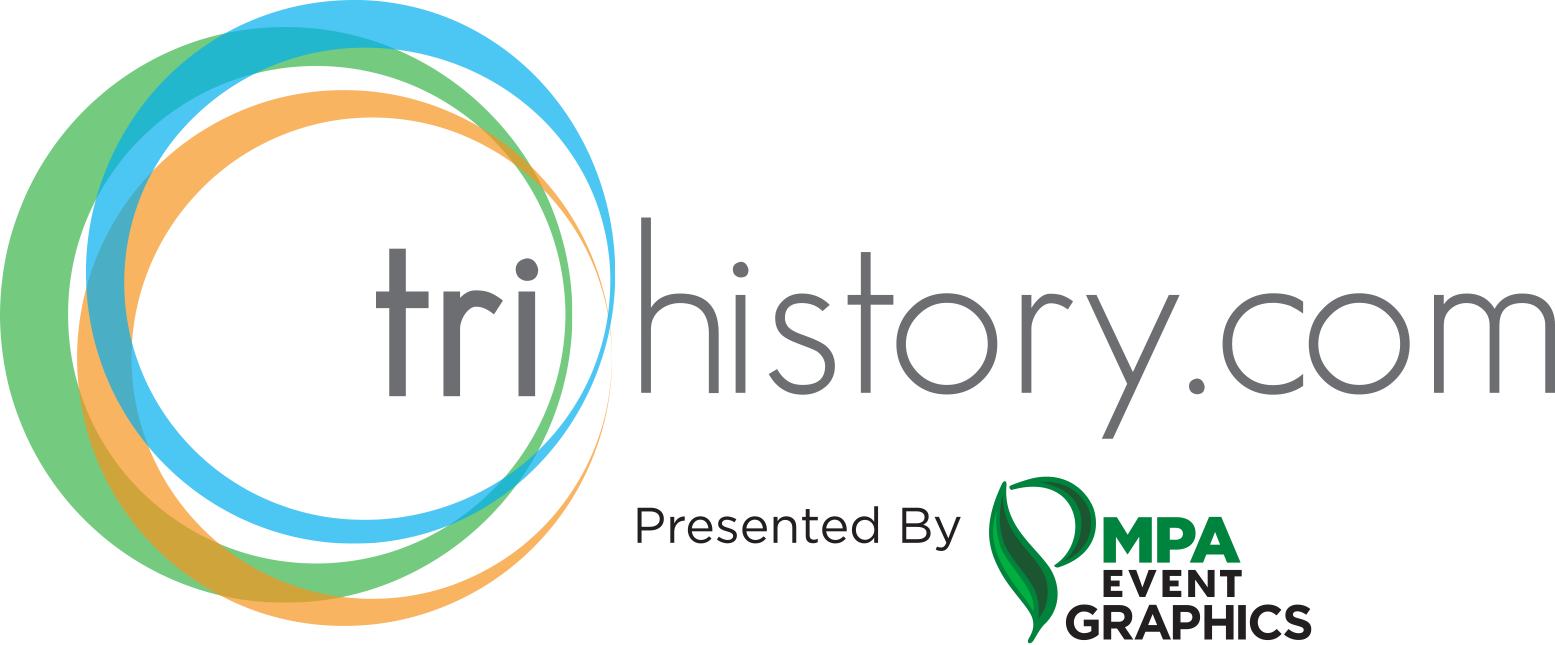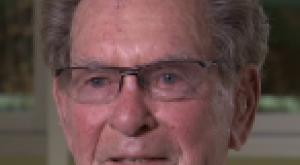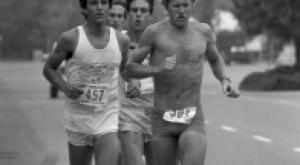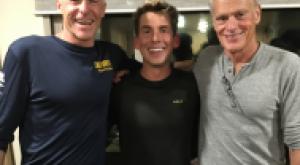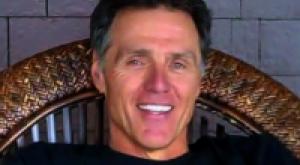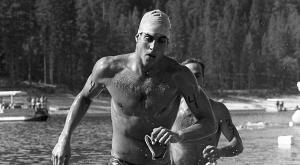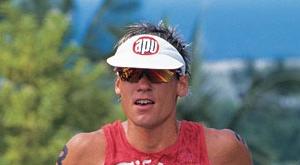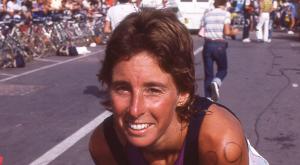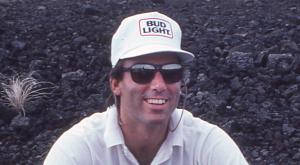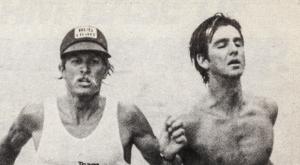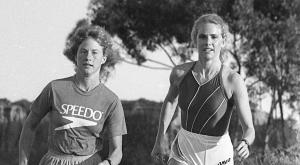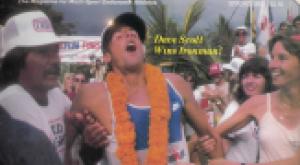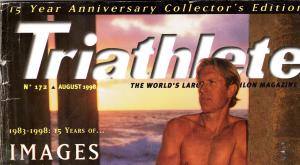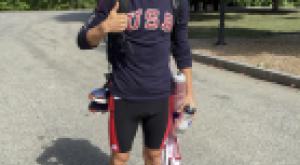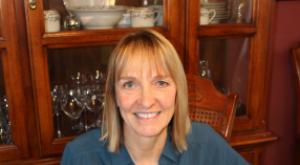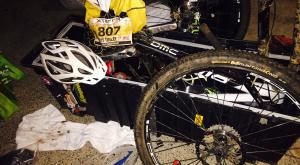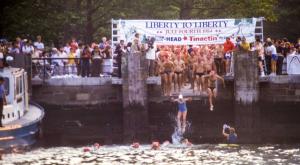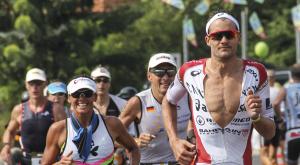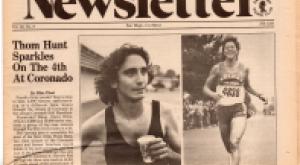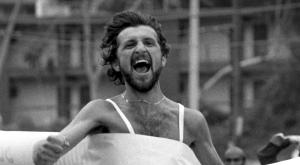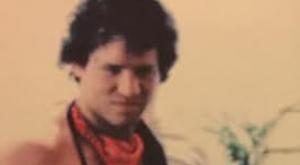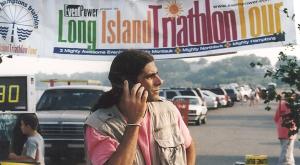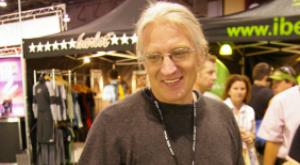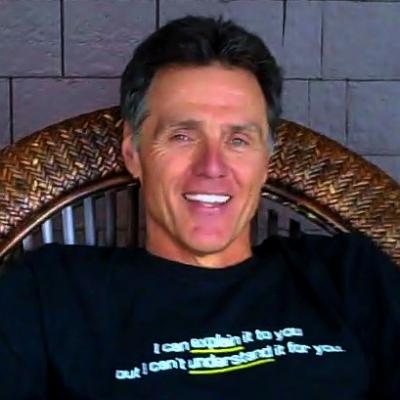
Back in the day when people were still looking at triathletes as if they were gods or fools, Miranda Carfrae was still in diapers, and fig newtons and chocolate chip cookies were the multisport energy foods of choice, a young man in Walnut Creek, California decided that he had what it took to be a triathlon coach.
Not that the 28-year-old Marc Evans was sure at the time there was a need for such a thing. But he had a hunch, born of his innate aptitude for organization. As the 1980s dawned and turned itself toward a future that would see cross-training and multisport competition become global phenomena, triathlon training was even more crudely cobbled up than the sport itself. Swimming had been a structured, scientifically coached sport for many years, and since many of the top triathletes in the early years were former competitive swimmers, that helped. But distance running, like multisport, was in its relative infancy (think Arthur Ledyard’s “long, slow distance” and Jim Fixx’s “The Complete Book of Running”), and long-distance cycling was a black box guarded by an elite cadre of purists to whom the perfect poof of a cycling cap was at least as important as the number of gears you were pushing. Triathletes couldn’t ride for shit, and that was that.
As it turned out, there was a need -- a big one -- and Evans was uniquely gifted to seize the opportunity and launch a new profession. Whether there had been other triathlon “coaches” before him is moot; Evans seems to have been the guy who made both a science and a career out of it, pursuing the concept of organized training for multisport competition with a passion that equaled the competitive fire of his clients.
In 2017, Evans is a past nominee for the USA Triathlon Hall of Fame, and can look back on a career in which he was decorated in every way someone in his position could be: head coach of Team USA at the inaugural triathlon world championships in 1989; founding member of the USAT Coaching Commission, head coach for USAT performance testing at the Olympic Training Center; Director of Endurance Sports for the Ironman Sports & Endurance Center in Kailua-Kona from 1986-88.
In 1990 he was named International Coach of the Year by SECURA, a Wisconsin-based insurance firm that emphasizes professional development in its sales training programs; the following year he received an Award of Excellence from the American Medical Association
Evans has written four books on coaching, and has written widely and lectured internationally. He’s also an inventor, holding patents on two swim paddles that bear the Speedo brand.
I’ve known Marc well enough since we both began in the sport decades ago. But before we sat down and spoke on the phone several times over the past six months, I had little knowledge of the context in which Evans became a coach. Nor did I fully understand his impressive, long-lasting influence on the science and psychology of multisport coaching. He is, as you’ll see, as much of a multisport pioneer as Valerie Silk, The Big Four, Tom Warren and all the rest. And while he claims to be stepping away from coaching, moving on to other things, his passion for the field burns undimmed.
-- Mike Plant

"Turbo Power," the "silliest thing" that launched a career and a profession.
MP: When you started back in the early 1980s there was nothing. Triathlon was barely a sport. What made you think, first of all, that this was something you could do; and second of all, that there was actually a market for it?
ME: It certainly wasn’t that I had the education, experience, or qualifications – no person did at the time. But I had a natural ability to organize in a place where there was no organization. That came from being somewhat dyslectic. In order for me to deal with things, I have to be organized.
I also tend to be extremely earnest about what I do, so I immersed myself in as much information as I could find about coaching swimming, cycling, running, biomechanics, text books -- which I tend to believe in, more so than what I call “The Monthly Magazine Syndrome.”
MP: When did you realize you had this slight dyslexia that caused you to compensate on the side of organization? I know you tried a lot of these theories out on yourself when you were still competing.
ME: To be honest, I didn’t know about the dyslexia, or understand it, until I’d been coaching for twelve or thirteen years after I started coaching. Until I was about forty. That’s when I came to understand and accept it as a blessing, because if you’re dyslexic and things are kind of upside down -- or, in my case, it was a problem with abstraction. So I don’t really buy into most of the articles that are written in magazines. Because they’re abstract. But I do buy into most scientific publications, because they aren’t abstract. I didn’t get it until I got help from a psychologist when I hit my 40s and I was dealing with some minor depression, which turned out had to do with this learning disability. I’d get so mad at myself about it. And I’d be forced to organize everything so much. The last twenty years or so I’ve just accepted it and realized that it helped me be more innovative in my thinking. I’ve lived a pretty good life with that.
The motivation to organize and to have all the questions answered as best as I could was exactly that: a compensation. If I had a workout coming up, I had to have every single thing about the workout organized. And some of those workouts were six or eight hours long, when I had eight or ten of those guys and girls together on a Tuesday, Thursday or Saturday. So every single minute was organized. And I had variety. I learned a key principle from the well-known and highly regarded masters swimming coach and good friend Kerry O’Brien. I’d watch him work, and I said,” Kerry, I don’t think you ever repeat a workout, do you?” And he said, “Nope, never have, never will.” And I said, “Oh, shit. I have four disciplines: dry land, swimming, biking and running. Do you know what you’ve just done to me?”
MP: So what were your early resources? Where did you go for information?
ME: There wasn’t much information back then, but there was physiology, and there were some brilliant books from Doc James Counsilman, the famed swimming coach out in Indiana. Brilliant guy. An absolutely brilliant guy. He had material that had an objective, scientific theme. I got a whole lot from that. And I got quite a bit of stuff from a Professor McCardle over at UC Berkeley, who wrote this classic book on exercise physiology. It was the kind of information that you could apply coaching principles to. That’s what I looking for.
There was also Tudor Bompa's classic, “Theory and Methodology of Training.” Bompa talked about physiological responses, workout durations, recovery times, and levels of intensity and periodization that are still used today. I loved reading and learning about the organization, science, innovation and application potentials, but with the three sports of triathlon, transition workouts, volume, density, intensity, frequency, dryland and weight training and countless variations, the model for triathletes was more complex.
I wasn’t looking to be a guru. I just wanted to know what I was doing. I wanted principles to know the intensity zones, how long you should be in an intensity zone, how much recovery you need. I like rules and the application of science mixed with innovative workouts and lots of technique development. If I was going to prescribe a certain workout I wanted to know the reason I was doing it. I was digging deep, going into all the places I could find. I invented my own systems, such as the Table of Periodization, but I had to start somewhere.
No one individual had a background in mixing swimming and running and cycling, and dry-land training together. I had to go out and learn how to do that. And quite honestly, I don’t think I became what I would call a master for 20, 25 years.
MP: Who was first client? You told me that you distributed fliers and suddenly you were a coach. Who was patient zero?
ME: My very first client was back in 1981. And when I say it was a client, it means I got paid. I wanted it to be a business. I wanted to make a living at it. I had written this training manual called “Turbo Power.” It was the silliest thing looking at it today, but it did demonstrate my interest and need to organize. I wrote about nutrition, and weight training, and running and swimming and biking technique. It was a self-made thing, about 50 pages long. But because I like to organized, I had to have something to give to people. I remember I was out riding one day with this bike racer up Mt. Diablo, and I said, “You know, I’m feeling like I want to coach triathletes.” And he goes, “What’s that?” And I said, “Well, there’s about five of them around town…” So like you said, I made a flyer, and this girl calls me -- her name was Jane; I can’t remember her last name -- she was a marathoner, but she couldn’t swim, so I started writing her programs. She paid me $135 for I don’t know how many gosh-darn individual sessions, and a training program, and that was my first client. It was probably the first-ever training program per se and I remember meeting with her every couple of weeks and physically mailing her workouts. I had to use a stamp.
MP: Arguably, you were the first guy to jump into the game as a professional coach. And Jane Doe, with a last name lost in history, is maybe the first coachee.
ME: (Laughs) That’s a great question. And yeah, she was probably the very first multisport triathlon client, because I was -- I don’t believe anyone would dispute this -- the first triathlon coach. I had not only written a manual, but I got paid for it in 1981.
But right after that -- it was really quick for me, because it was such a small population of people -- I got a call from Sally Edwards, and she asked who the heck I was. She’d seen one of my fliers. “Who the heck are you?” Of course, Sally was a pretty talented endurance athlete.
Anyway, guys started coming to me, and we started having success based in Northern California. Dean Harper came to me. Dean was an extraordinarily gifted athlete – a pioneer in triathlon, and a kind person to everyone. Dean kind of gave me my start. He needed some kind of organization in his training. He’s still one of my best friends in life. Then Ferdy Massimino, who was tenth at Ironman (Oct., 1982). People kind of trusted me, and kept coming. It just kind of exploded. I was making a good living. And I set about learning as much as I could. I spent countless hours at the U.C. Berkeley library, the Stanford medical library...
We ran swim workouts, track workouts, amazing cycling workouts. I’d run the workouts on the pool deck, the track, and I would be in my car during cycling. I had a CB-radio and a bullhorn. I would motor-pace the guys too. I remember motor-pacing Sean Molina one time like a hundred and ten miles in three hours -- out in the delta area, where at that time there was no traffic. I was just talking about this to Dean the other day -- they were just really good times for all of us. They were having great results and honestly, we loved being from Northern California and racing the Southern California triathletes.

Road Trip. With Dean Harper, 1985

On the road with Sean Molina
MP: You were very quickly working with some of the best guys in the sport back then: Dean, like you say. And Sean Molina. Who else was part of that group up there?
ME: We had Dean, Peter Cazelet, Alexandre Riberio and the younger Molina brothers Sean and Phil…There was another guy, you probably never heard of him, but he was probably the best athlete we ever had: his name was Rick Suchomel. He won seven races one summer, including the Monterey Bay Triathlon. Rick was this All-American swimmer. We developed his running and biking, and he ran down -- twice I think -- Chris Hinshaw. Rick had a kind of obsessive personality and couldn’t hang in there. He got injured. But he made his mark for a short time.
Mike Pigg came down a few times and I would chat with him at nearby races. This was before Mike Pigg was Mike Pigg. He was at a regional race and I saw him running in a half-Ironman event. He was just this ball of energy. He was a sponge -- honest and earnest. He came up to me and asked, “How do I get my swim better?” I told him to swim with the girls at Humbolt State University up in Arcata where he lived. I’m not saying that you can attribute anything about Mike Pigg to me, but you just kind of knew when you were talking to him that he had the capacity for greatness. It was there with Tinley, it was there with Dave Scott, it was there with Mark Allen, it was there with Mike Pigg. And you can see when it’s not there.
What really happened was that I had this group, and then I started getting busy with amateur clients coming in who wanted to be with a good coach. Of course, I was the only one. So it really propelled my career. I had a very nice business for many years. I never told people, but I was making six figures coaching for fifteen, eighteen years.
MP: Wow. I never realized you were doing that well.
ME: Well, this is probably the first time I ever said that publically. I kind of kept my mouth closed about it. I was coaching many amateurs who were coming into our facility. Even Joe Friel came out in the mid 1980’s and said, “I want to do what you do…” I didn’t know Joe or anything about him, but he wasn’t a technique coach and was open about that. Who would have dreamed he would change endurance sport coaching almost single-handedly with his approach to data-driven training programs. We’ve had entirely different approaches to what coaching is, but his contributions have been extraordinary for online coaching/training program coaches.
MP: It’s pretty hard to miss from your writing and from the people you’ve worked with, that individualized coaching has is a central theme in the Marc Evans method.
ME: I always wanted to coach individually. Everybody I saw got individual lessons. I felt frustrated by group coaching because it felt only half-way. People come with so many physical, cognitive, musculoskeletal differences. I knew that while group training is necessary in some cases, the principle of individualization is central. So that’s the nexus of what I do. It’s what I did for many years, and I made a very good living at it -- for 18, 19 years until too many coaches started jumping into the sport and USA Triathlon starting certifying people with absolutely no experience whatever. And more importantly, no requirement for the evaluation of competency. They may do something different nowadays, but after 2000 Olympics it all changed. There are good people at USA Triathlon, and they are doing their best to be sure, but many of us who’ve coached for a long time agree there should be more to certification in the demonstrations of teaching skills and perhaps, a mentorship aspect as well.
I would eventually only coach groups if there was also a requirement for individual evaluation of mobility, stability, flexibility and technique, and then correctives. I know the value of group training, but with the individual stuff, you get to the cognitive, you get to know the person, you get to deal with their doubts, their insecurities, their strengths and weaknesses. Dave Scott and I talked about this many, many, many times -- about how important the mental, cognitive, stuff is.

Evans leads a training session on Mt.Diablo in 1984

Evans' 1994 book, "Coaching and Training Techniques"
MP: I can certainly relate to that personally, because I was a springboard diving coach. That is not a one-size-fits-all sport. The psychology is so important. The physical ability of the athlete is important, of course, but the way the diver deals with him or herself on the board and in the air, how they handle the pressure - all that is critical. You had to coach each person individually. So I get it.
ME: There probably is no better example than diving. You’re on the board or the platform, whatever, and you’re exposed to a high level of risk, you’re being judged… You gotta be present. You have to be aware. Individual coaching, individual sessions, helps you do that in an environment where you can also quantify lack of movement, lack of stability, lack of mobility, so you can help the athlete become more technically efficient on an individual basis. For example, we know that compensations in movement are often the result of instability in the pelvis. If you’re coaching a group, and you don’t assess that person, then only some of the people are going to rise to the top, because the others will be dealing with undiagnosed compensations and injuries.
I felt at the time that the assessments of movement -- not by me personally, but by my physical therapist -- would help identify what was needed, what exercises were needed for them, individually. And, the training programs would be - and I credit the Table of Periodization, which was a massive Excel spreadsheet -- to do the same thing with intensity, recovery and volume. Each person has a unique ability to tolerate volume and intensity -- by age, by history, by event choice. I had the information that allowed me to do that… Here’s the key word: Teaching. That’s what missing today with all the emphasis on data. That’s what’s missing.
MP: It strikes me that a lot of the coaching now is formulaic. That’s probably necessary because of the sheer volume of triathletes who need help. And it’s probably all very scientific, but you’re pointing out something that was very easy to lose along the way: the individual attention to personal details, whether they be psychological or physical.
ME: I’m not saying we shouldn’t embrace technology. Or group coaching. I think what we’re seeing, if I’m being completely fair, is that everybody is drawn to technology. You can have your workouts delivered to your smart phone… People are attached to the data. They ride their bikes using their power meters, their GPS watches, yet it’s a different kind of coaching.
Look, like in football: there’s a backfield coach, a line coach, a special teams coach, a quarterback coach. In endurance sports there are coaches who are teachers and educators, and then there are the training program coaches. So it might be, that we just need to say, “Hey, that’s not a bad thing, it’s just that some of these people just aren’t coaches.
And that’s what I think has happened: the recreationalism of endurance sport has changed the landscape into one that’s dominated by coaches who offer training programs, but don’t address mobility, flexibility, stability, technique; they don’t teach, they don’t address the cognitive, they don’t do any of that.
So it’s really a definition problem, I think. I’ve written about this, talked about it. I think it would be helpful that when coaches are delivering programs online they use a term like “programming coach,” something like that. So the public knows…I think it’s great if somebody wants to go do the Ironman in New Orleans, or Maryland or wherever, and they get a training program where they don’t see the coach, and where there are no movement or technique analytics. But there needs to be, in fairness to those like me and others, who actually are coaches, teachers, educators. It’s about defining what coaches are. I don’t like calling myself a coach because it’s too common today and less defined about what that actually is.
If you’re a triathlon coach, and all you do is deliver training programs via the Internet, and you never see the person, I have to say that’s not really coaching. It’s just not. And people pay a fortune for that. Some people pay three, four, five thousand dollars a year for some of those programs.
MP: So what you’re saying is that online coaching has its place but it’s not a holistic approach.
ME: I believe it has its place. Very much so. I want to be fair. The problem is the definition. For a while what I was planning to do -- I wrote about this in my last book, “Triathletes in Motion” -- I had a one-hundred-hour undergraduate and graduate curriculum to educate some of these coaches on how to do evaluations of movement and technique, and be a resource coach for their clients. I thought we could set up an education program locally where we address mobility, stability, flexibility, technique; we give them all the correctives. My goal was to help the athlete do better with what the online coach asks them to do. If the coach never sees the athlete, we would be a good resource for them.
MP: What was the response? Did you actually launch the program?
ME: We invited a lot of coaches in the Boulder area to participate. But there wasn’t much of a response. Offered USA Triathlon a chance to have me come in and present as well. My physical therapist partners at my office think it’s because coaches don’t want to be seen as not very knowledgeable. Interestingly, it was the kind of second-tier coaches who didn’t want anything to do with this. The top of the food chain -- the Dave Scotts, the Darren Smiths, the Siri Lindleys -- they were very interested. Which is another thing: you always see that the top people tend to be the most open. They want to learn. I closed the office after about a year.
MP: Isn’t that the way in anything? Isn’t that the way in sport generally? The top people are the ones who are willing to put in the extra work, do the extra training, go the extra mile to improve and succeed. That pays off, doesn’t it? Like in the second half of the marathon in Kona.
ME: It does. But again, I’m not trying to beat up on those guys. I’m just saying -- and I suggested this to USA Triathlon -- let’s have a label or a definition of the type of coach they are. You can’t call these people coaches if they’re just a training program coach. The public needs to know that. That’s all I’m saying. Some of them might have good training programs. It’s just not my style. There is clearly a need for that kind of thing. People are busy, they just want to feel they have a general template. That’s fine. But don’t call them coaches, because if they don’t see you in person… if they’re not on the deck sitting in that chair like a diving coach, looking at how your hips flex, or how you breathe, or where your eyes are looking, or your distal/proximal motions, load transfers of energy from the pelvis and all that, then they’re not really coaching in terms of coaching education and “teaching”. That’s probably as important a point as anything. It’s just taken me a while to frame it.
Honestly, I don’t have skin in the coaching game any longer so, this isn’t about my getting more clients. Yes, I still work with people, but I limit this to six clients on a full time basis and do some clinics and consulting. My main work now is product design, research and patents with my company, Sports Engineering Group – all based on my books as the basis for the principles of how our products that develop technique function.
MP: Going back to the advice Kerry O’Brien gave you, it’s pretty hard to see individualized coaching as a part-time job.
ME: In all the years I’ve been doing this -- and there were many years when I had 30, 35 clients a year, full-time -- do you know how many thousands, probably hundreds of thousands, of workouts that I wrote that were stand-alone? I’m talking the whole set: interval, distance, intensity, terrain, all that stuff. Just because of Kerry. I’m proud that I always did that. Now, there were a few generic plug-in, technique workouts for recovery or something like that, but for the most part, I’d say ninety-five percent of everybody’s workouts were individualized.
I guarantee you, some of these online programming coaches, I will guarantee you… (Evans leaves it at that, but the implication is clear. A lot of folks just aren't getting deep enough into what he sees are the fundamentals on his craft.)
One of the things I always said, “If I can’t earn a living then I won’t do this anymore." Well, a lot of top coaches – those who get the most attention -- don’t actually earn a living just from coaching a group of athletes. I’ve told them they need to charge everyone – at a rate that gives them a good living.

With Doug Akagi on the pool deck in 1984.

Peter Cazelet
MP: You can certainly see where the techy, online coaching industry would be attractive to triathletes, who have been on the cutting edge of new and different from the beginning.
ME: I certainly understand that. And like I say, online coaching has its place. It’s one of the things… I mean, triathlon has created so many things! It’s had such a wide impact: training programs, online coaching…I mean there are thousands of cycling coaches around now, and running coaches now. All because of the demand for triathlon coaching. The aero bars, the wetsuits from, like, Dan Empfield with Qunitana Roo back in the 90s. I mean, Dan is like the president of triathlon. He’s everywhere. It’s geniuses like that. Training Peaks -- this massive, massive online training portal. They don’t have content or methodology; they just deliver data for coaches.
One of the things that has always been part of triathlon is “HOW?” How do I do that? How do I put three sports together? That was the reason people hired us. That’s still there today. It’s just in many instances it’s not coaching or teaching, but data.
MP: It’s funny, but I remember being surprised by that -- at least early on. I always thought triathletes in the early days were too iconoclastic to be all that coachable. But that wasn’t true at all. I remember sitting in a seminar back when Jim Curl, Dan Empfield and I brought back the USTS in the late 90s. I listened to John Cobb talk about wind-tunnel testing, and the optimum position of a person’s thumb on the aero bars. To be more aerodynamic, you know? There were 50 people in the room, and they were rapt! You couldn’t have torn them away if there was a bomb. And I thought, what the hell is this? The thumbs? Triathletes have proven themselves to be sponges for anything; they’ll go off in any direction if it will help them improve, or even hints at technology.
ME: Yeah, I think you’re right. John Cobb didn’t know much back then, but he had something techy that triathlete’s were drawn to. There is this technology drift. Guys are feeding their families being bike fitters. That’s a good thing, but it’s incredible. Technology is so attractive to people. They love apparatus, they love gadgets.
But what gets lost is all the stuff we’ve been talking about: the neuromuscular training of technique, cognitive training, movement and stability assessment, coaching, teaching, education, instruction… It’s layered; it’s all together. It’s not like any one thing unto itself. But when people get on technology, they think that’s the end of it. Look at the bicycle industry – it’s built upon getting speed, without training.
MP: It’s a good point. I wrote about that for Outside magazine back in the 80s. Triathletes are broadly affluent, and it was not uncommon -- I gather it’s still not -- for someone to think that having the best equipment is somehow going to make up for what they can’t do, or aren’t willing to do, physically. The best gear gets you to the starting line, but the sport has always been a mental thing. Eventually you have to get back to that. At the end of the day, it doesn’t matter how good your bike is -- within reasonable limits, anyway. It’s an individual sport, and if your mind is better than the next guy, and he has $300 shoes and you have $50 shoes, you’re going to beat him anyway. You’re better prepared to go deep and understand what it takes to get to the end.
ME: Yes. It’s really what the top athletes have. And what the top coaches work on. There’s probably no more important thing than what’s between an athlete’s ears. And what people tend to do with technology is use it as kind of a screen that keeps them from dealing with the deeper factors. I don’t see technology as much of a benefit without the coupling of many other and more important aspects of training – physical and mental.
Scott Tinley, who I coached for a few years via a training plan, told me this one time; I’ve never forgotten it: “At a given point, you have to know the reasons why you’re out there.” That’s the kind of thing that can get you through a bad day -- and helps you make the most of a good day, too.
MP: What do you see as being the biggest advances in the industry since you started? I mean, performance is improving at almost every level, but most stunningly with the elites, where you have these guys like Javier Gomez and the Brownlee brothers running low 29-minute, even sub-29 minute, 10Ks on the ITU circuit. And guys going close to eight hours flat in Kona. Gwen Jorgensen for the women at ITU, and Miranda Carfrae at Ironman, with marathon times well into the top ten overall. What’s made the big difference? Is it the fact that more people are involved and that more people are training full time? What are the advances leading to these kinds of performances?
ME: The difference on the ITU side? I think the ITU will be the most interesting thing in the sport in the years to come. Ironman is so saturated that it’s very difficult to see who’s the best. There are just too many events. And too many second, third and fourth-tier athletes.
To your question: I think the reason they’re running so fast is that they’re biking slow. I don’t believe that their bike splits in these 40K draft-legal races are faster than Mike Pigg’s 40K stand-alone 25 years ago – and some of the amateurs I coached went fifty-seven minutes for 40k in the 1980’s. Mike’s was faster, Mark’s was faster, Dave’s was faster. I have a feeling that they’re running better simply because they’re great runners. And the event characteristics are very specific – much easier to train for. Of course, the athletes are very talented as well.
See, this is another thing about that goes along with what I said about coaching, about defining different kinds of coaches. I don’t think they should call the ITU format simply the Olympic triathlon, but the Olympic draft-legal triathlon. It’s different than stand-alone. It’s a different event, like the 1500-meter freestyle, the 200-meter butterfly, the 400 meters in track & field, etc. It’s a different discipline, and eventually there’s going to be other triathlon disciplines; there’s going to be maybe relays, maybe an Ironman-distance race, eventually coming into the Olympics. And I think what you’re seeing is an entirely different discipline from the triathlon many of us original pioneers in the sport knew it to be. I wish that they would characterize it, classify it, so the people coming into or viewing the sport understand that draft-legal is simply one discipline within a larger sport.
Nevertheless, like I said, I think at the ITU level for both the men and women are equally interesting to watch as a discipline. I think that’s important to distinguish.
MP: So the advances I asked about? Do you see much of that at all in terms of contemporary performance?
ME: Well, in the old days we felt that if you could run 30, 31, 32, 33 minutes 10K stand-alone, that’s what we’re gonna train you to run off the bike. That’s what we did in the old days. We looked for specificity in the training. If you want to run a 2:40, 2:45, 2:50 marathon off the bike, we need to train that way -- not all the time, but sometimes. Some of that seems lacking for the men at Ironman, but the women are impressive – and I think women are more open to coaching in general.
MP: So what you’re saying there is that in the old days a guy like Tinley might be able to run a stand-alone 31-minute 10K, you would train him to run a 31-minute 10K off the bike -- basically to run in a triathlon up to 100% of his capacity as a pure runner.
ME: We could get pretty close. Assuming the capacity was there. The guy that I coached who was closest to that level was Peter Cazelet. I got him when he was like 14, and by the time he was 16 or 17 he was on the cover of Outside magazine. He was that good. He had this amazing swimming background, and lung capacity, and genetics. He was so used to working at high thresholds it was not unnatural to him. But anybody I worked with, we really focused on that classic word: “specificity.” That’s what we were trying to do -- off the bike, in practice and training. The best example is Mark and Dave running 2:40 marathons in Kona in 1989. Ask them both: you don’t do that unless you practice it, train for it. It just doesn’t happen.
You sound impressed by some of the times, but I’m not that impressed, to be honest. I really am not. Especially given all the quote/unquote technology and nutrition and equipment and all that.
MP: That’s so interesting. I don’t believe I’ve heard that opinion before. But I guess if you look at it simply in terms of time, it makes some sense, considering the relatively fresh legs off the bike and the caliber of the runners.
ME: The guys at the ITU, they know what they have to do. They have to be able to run 29, 30. Hello? Specificity! Actually, it’s probably an easier thing to do in terms of training specificity than in the old days, because the margin for error is so small and the event is so different now – draft legal. You have to be within a certain distance of the lead in the swim; you have to stay in the pack on the bike; you have to be on the rivets on the run -- and that in the last eight-hundred to a thousand meters you will be up to your anaerobic capacity. You have to train for that. And you have to train for a 100-meter, 200-meter sprint at the finish. So it becomes this very interesting dynamic with just the smallest windows of error -- which is where specificity comes into play at a micro level.
At the macro level at Ironman, I think it’s the same thing: you have to hit the targets; you have to have the physical capacity to hit them, but you also need the mental fortitude -- which is probably the biggest thing. That’s probably the biggest thing that Mark Allen did for Tim O’Donnell at Ironman a few years ago -- getting him to believe. Cognitive, cognitive, cognitive. And no one better than Mark – he would have won eight or more Ironman titles with the cognitive skills he eventually learned and combined with his impressive physiological gifts. That’s coaching. That’s teaching.

From left: Sean Molina, Phil Molina, Eric Hansen, Marc Evans

Evans in Avignon, France, as coach of Team USA, 1989
MP: You’re moving away from coaching. The sport has changed and continues to change. Where do you see triathlon in ten years? Let’s say three Olympic hence, so say twelve years
ME: Yes, I’ve written a few books and am now focusing on designing technique products, patents as I mentioned earlier. I love this work. For triathlon, I would like to see a growth of what we were doing in the 80s -- small groups being organized and coached individually. You’re seeing the same thing now with coaches like JamieTurner at the Olympic ITU level, and Darren Smith, Siri Lindley and Joe Fioli, and a few others -- I’m sorry about the ones I’m missing. One of the problems you have now is that these independent coaches don’t often get support from their federations.
As for the Ironman? To be quite honest, I think it’s a housing bubble. I don’t even know if it will even be here in fifteen or twenty years. There are just too many events. Just too many. I hope I am wrong, but it seems growth has a limit in sustainability as many participants may not be long-term triathletes.
MP: I sounds like what you’re saying is that the sport needs to focus on the very thing that you began with: this whole idea of the need for individual coaching. We need to either come back around to that, or at least be careful we don’t lose it.
ME: That’s what I meant about the group coaching and the federations supporting these non-federation coaches. If the federations could help fund physical therapy evaluations, then neuromuscular load-transfer training improves, injuries go down, assessments of mobility and stability go up; the coach knows what they can and can’t do. There needs to be a coupling of other experts to help the athletes… Just like in all sports. There’s strength and conditioning, there’s technique, there’s physical therapy, there are athletic trainers. We really need all that. And to be honest, I think we’re still in the Wild West. I think we’re still pioneering, and I think we may see extraordinary gains in the future once we get all that figured out.
Again, I think the ITU has the most potential for growth and interest, from a participant’s point of view but also from in terms of viewership and the general public.
The Ironman has a coaching university. So does Slowtwitch. And all you have are a lot of generic coaching certifications and training programs. There needs to be workshops and principle-based content and assessment of competency. I mean, I saw the last Ironman broadcast from Kona on the Internet -- I love watching the raw feed. They interview all these coaches, and a coach has maybe forty clients at the Ironman. That’s not coaching. There’s just no way you can coach forty people, especially at that level. There will probably be a shift away from that over time, but it’s online coaching that gives them the best way to make a living. But it’s not coaching, teaching.
The real shift I’d like to see is that the top coaches get paid for what they do. And there’s a trend where they aren’t making it. The athletes need to pay them so that the other levels of coaches at the regional level, etcetera, realize that, hey, this is a profession.
MP: I’ve certainly seen and heard this push/pull kind of discussion in other industries. For instance, there is a sharp division in terms of education between a physical trainer you might run into at your local fitness center and a certified athletic trainer or licensed physical therapist. Some industries have addressed the issue of definition, some haven’t.
ME: I think the thing that would really help is if USA Triathlon and the other federations raise the entry level coaching certification to where it actually requires teaching, coaching, instructing, evaluation of competency -- not just finishing a written exam. USAT, bless their heart, their entry level to certification is so low. I wish they would raise that a little bit in the long-term it would be great for coaching, coaches and the athletes they work with.
The analogy I like to use is if you, Mike, go up to the ski area and you’ve never skied before and you say, “I want to take ski lessons.” You have a reasonable expectation that the person teaching you knows how to ski and teach - safely. You don’t have that in triathlon. Before I recently moved from Colorado, I don’t know how many Level One triathlon coaches there are. But there are so many. And almost none of them know how to swim, let alone teach it. That’s just wrong.
The coaches should learn how to teach and demonstrate competency and pass a meaningful certification. Rather than populating the business with so many coaches, the federations should up the level. If someone wants to be a triathlon coach, let them be an uncertified triathlon coach. Who cares? It’s a free country. The people you do certify, make sure they can teach. Up the level of education to include the demonstration of teaching skills. You can pick your own curriculums and definition of what that is. You can pick mine, or you can pick someone else’s. But at least have that definition, that curriculum. You will make a better sport. The athletes will be better, and it will make it so these coaches can actually learn a living. I always said, if I don’t make a living, I’m out. The last eight years or so the sport is so saturated with coaches. Mark Allen will tell you that. Dave Scott will tell you that. Siri Lindley will tell you that. Darren Smith will tell that. There’s too many coaches.
And conversely, I say to the coaches, make sure you’re charging those elite athletes. So it gets down to the athlete population: Hey, coaching is a profession.
That’s my hope for the future of coaching. I just hope that of the federations are interested in stepping in; that they reach out and talk to some of us who have been around for a while. Make it a challenge for people to become a Level One certified coach.
Scott Molina told me -- this was a very key thing in my early career -- he said, “Marc, you need to be the best teacher in all three of these sports.” And you know, Molina and those guys, that’s all they wanted to be; they wanted to be the best. That still puts chills in me. I can remember the minute he said it, where I was, what I was doing. You need to be the best.
To learn more about Marc Evans and his most recent work, visit https://www.facebook.com/MarcEvansEnduranceEducation/

Evans and his Triathletics West team in 1987.
